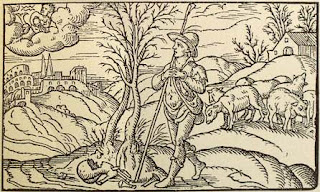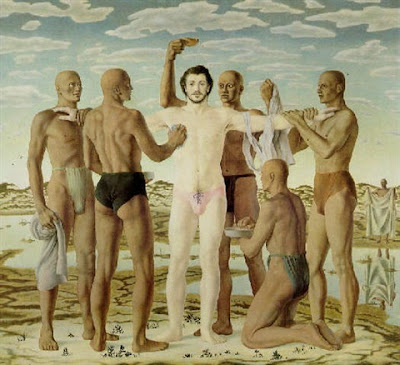The Trickster and Creativity.
Lewis Hyde’s probing work makes an interesting read. His style of writing, though it lacks the alchemical/poetic precision of Bachelard, is rich and provocative. It was Blake, almost 200 years ago, who imagined a world beyond good and evil and simple binary oppositions. He was able to dream beyond God, Ratio, Reason and Urizen. The other side of the equation was always needed. In one sense, Hyde’s work takes off from this point. He argues for “disruptive imagination” as a balance to order. His survey of the trickster gods shows the dark side of culture: a vital side of culture.
Jung and Kerenyi, in the middle of the last century, wrote telling studies of mythology. Powerful, imaginative works. But there world was invariably a classical one. Hyde’s achievement is that he investigates and includes a wider view of mythology. His heroes are Hermes and Mercury, but also Coyote, Loki, and Eshu (of course!)
Trickster makes the World is divided into 12 chapters, a sort of anti-Homer. Of particular interest are “The God of the Crossroads”, “Speechless Shame and Shameless Speech”, “Trickster Arts and Works of Artus”, and a fascinating section on the racial perceptions of Frederick Douglass: “Frederick Douglass and Eshu’s Hat”.
In “Trickster Arts and the works of Artus”, Hyde summarises the “disruptive imagination as this:
“Attacking the joints to actually destroy something, or attacking the joints so as to change the shape of things: these are the first two senses in which tricksters are artus-workers and their creations works of artus.”
Art is art-iculation, a joining of bones, as it were, and tricksters work to re-arrange the skeleton of the body-politic, to show its darker and deeper realities. Tricksters (especially as artists) work with moving joints, joints that can slip in and out of place. Trickster novelists are those that dislocate the novel or poem to create a different awareness of place. It’s a pity that Hyde (as a creative writing professor) did not pursue these theme into details, but perhaps that is for others to do. Hyde’s conception of artist-trickster is an important image for the study of Marechera. As an artist, he was well aware of the trickster in African mythology—how art is rooted in dirt—and what modern critics have described as “carnival” in Marechera’s work really ought to be viewed as the trickster at work. Marechera’s constant disclocation of the modern novel is not an act of madness, but an example of the “disruptive imagination” at work.
Very interesting is Hyde’s belief that the Trickster and the Shaman stand as poles. Both are marginal figures. Yet they are very different in nature. The Shaman, though operating in an ambiguous world, must show single-minded purpose. The ambiguous trickster operates in a single-minded world so as to open that world to double-sided contradictions. The story of Eshu disturbing the peace of mind shared by devoted friends exemplifies this distinction. Eshu does not tolerate single-minded simplicity. Humour, for Hyde, identifies the trickster: with humour the world begins to slide. (Think of Joyce in Finnegan's Wake or Rushdie in Haroun and the Sea of Stories).
Trickster makes this World is a penetrating survey of discontinuity, a great source of disruptive ideas.
Jung and Kerenyi, in the middle of the last century, wrote telling studies of mythology. Powerful, imaginative works. But there world was invariably a classical one. Hyde’s achievement is that he investigates and includes a wider view of mythology. His heroes are Hermes and Mercury, but also Coyote, Loki, and Eshu (of course!)
Trickster makes the World is divided into 12 chapters, a sort of anti-Homer. Of particular interest are “The God of the Crossroads”, “Speechless Shame and Shameless Speech”, “Trickster Arts and Works of Artus”, and a fascinating section on the racial perceptions of Frederick Douglass: “Frederick Douglass and Eshu’s Hat”.
In “Trickster Arts and the works of Artus”, Hyde summarises the “disruptive imagination as this:
“Attacking the joints to actually destroy something, or attacking the joints so as to change the shape of things: these are the first two senses in which tricksters are artus-workers and their creations works of artus.”
Art is art-iculation, a joining of bones, as it were, and tricksters work to re-arrange the skeleton of the body-politic, to show its darker and deeper realities. Tricksters (especially as artists) work with moving joints, joints that can slip in and out of place. Trickster novelists are those that dislocate the novel or poem to create a different awareness of place. It’s a pity that Hyde (as a creative writing professor) did not pursue these theme into details, but perhaps that is for others to do. Hyde’s conception of artist-trickster is an important image for the study of Marechera. As an artist, he was well aware of the trickster in African mythology—how art is rooted in dirt—and what modern critics have described as “carnival” in Marechera’s work really ought to be viewed as the trickster at work. Marechera’s constant disclocation of the modern novel is not an act of madness, but an example of the “disruptive imagination” at work.
Very interesting is Hyde’s belief that the Trickster and the Shaman stand as poles. Both are marginal figures. Yet they are very different in nature. The Shaman, though operating in an ambiguous world, must show single-minded purpose. The ambiguous trickster operates in a single-minded world so as to open that world to double-sided contradictions. The story of Eshu disturbing the peace of mind shared by devoted friends exemplifies this distinction. Eshu does not tolerate single-minded simplicity. Humour, for Hyde, identifies the trickster: with humour the world begins to slide. (Think of Joyce in Finnegan's Wake or Rushdie in Haroun and the Sea of Stories).
Trickster makes this World is a penetrating survey of discontinuity, a great source of disruptive ideas.




Comments